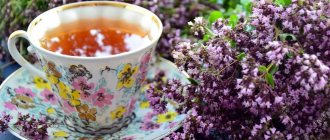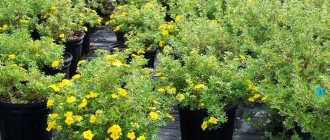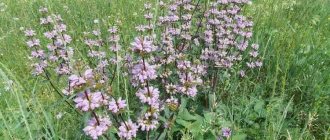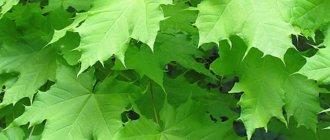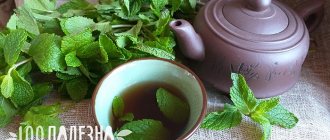Thyme (or thyme) and oregano are medicinal herbs from the Yamnotaceae family. They have similar purple-lilac inflorescences of small buds and a specific spicy smell. Plants are used in homeopathy, cooking, and cosmetology. The external similarity of herbs often raises questions: are oregano and thyme the same thing or not, and are they interchangeable in recipes? However, herbs have differences in chemical composition and have different medicinal properties. Without risk to health, you can replace one plant with another only in cooking.
How to distinguish thyme from oregano
During the flowering period, the herbs are easy to confuse: they have similar small buds of pink-violet and purple shades. They form in mid-summer and have an almost identical bitter-spicy odor; in thyme it is more pronounced. Buy ready-made mixtures in pharmacies and trusted online stores, since the differences in dried raw materials cannot be visually detected. However, freshly harvested grass has characteristics that allow you to determine which representative of the Yamnotaceae family is in front of you.
Table 1. Comparative characteristics of plants
| Thyme | Oregano | |
| Stems | Recumbent or ascending, branched, spread on the ground, forming a subshrub | Tetrahedral, erect, slightly pubescent |
| Root | Woody, rod-like | Naked, sometimes crawling |
| Grass height | 0.20–0.35 m | 0.5–0.8 m |
| Leaves | Small, hard, oval or elongated, with short petioles | Oblong, pointed at ends, opposite |
| Inflorescences | Capitate or elongated, corolla light purple, pink-purple or white | Corymbose-paniculate, tubular buds, purple-pink, lilac corolla with protruding stamens |
| Fruit | A box with round or oval dark seeds | Brown-brown small nuts |
| Healing properties | Mucolytic, antiseptic, anti-inflammatory, healing, antispasmodic, analgesic | Bile- and diuretic, expectorant, sedative, tonic, bactericidal |
| Compound | Vitamins of groups C, B, thymol, carvacrol, triterpenoids, tanning components, micro- and macroelements | Ascorbic acid, essential and fatty oils, sesquiterpenes, coumarins, flavonoid fractions, minerals, vitamins A, D, B |
| Other names | Thyme, Bogorodskaya herb, thyme | Oregano, incense, oregano, forest mint |
Useful properties and contraindications of thyme and oregano
Healing plants, when used correctly, are effective natural remedies for fighting diseases. When making infusions, follow the recommended proportions. Violation of the dosage regimen, exceeding dosages are fraught with complications: the appearance of nausea, vomiting, dizziness, pressure surges.
Before treatment, make sure there are no allergies or individual intolerances to herbal components. Oregano and thyme have differences in properties and chemical composition; replacing them in recipes is unacceptable.
Uses of thyme
The plant has disinfectant, antibacterial, and regenerative properties. The herb extract is used in pharmaceutical production and is included in cough syrups and soothing preparations. Thyme-based products are used in the following cases:
- diseases of the mouth and throat (stomatitis, gingivitis, pharyngitis, sore throat);
- insect bites, rashes, abrasions, skin lesions;
- colds, ARVI, bronchitis - to improve sputum discharge;
- disorders of the digestive system;
- decreased immune defense of the body, fatigue, lethargy;
- insomnia, nervous tension, stress;
- alcoholism (to develop a stable aversion to alcohol);
- prostatitis, potency disorders (as part of complex treatment).
Bathing your baby in a herbal decoction will relieve anxiety and speed up sleep. Oral administration is prohibited for hypertension, heart and vascular diseases, liver and kidney pathologies, and thyroid disorders. The use of thyme during pregnancy and lactation is permissible only with the permission of the attending physician.
Application of oregano
In folk medicine, the plant is used to combat gynecological pathologies. The hemostatic and anesthetic effect of the herb alleviates the condition of painful and irregular menstruation. The bactericidal effect prevents the development of inflammatory processes in the genitourinary system. Herbal infusions are used for conditions such as:
- menopausal changes in the female body;
- gastrointestinal pathologies, loss of appetite;
- erosion of the uterine cervix;
- risk of developing mastopathy;
- nervous disorders, sleep problems;
- high blood pressure;
- weakened immunity, decreased body tone;
- colds, upper respiratory tract diseases;
- swelling, dysfunction of the urinary system.
Masks with oregano extract renew the skin and strengthen the hair. Tea with brewed leaves of the plant stimulates weight loss, removes excess fluid and harmful substances. For stomatitis and tonsillitis, rinsing will reduce pain and inflammation. Bathing in the broth helps prevent diaper rash in babies and dries out rashes.
Contraindications to the use of the herb include: the period of bearing a child, pathologies of the heart and blood vessels, stomach and duodenal ulcers, gastritis with high acidity. When breastfeeding, discuss the use of herbal infusions with your pediatrician.
Are thyme and oregano the same thing or not, similarities and differences between plants
In the article we tell you whether thyme and oregano are the same thing or not.
You will learn the similarities and differences between these medicinal herbs, as well as what dishes they are added to. Externally, these plants are so similar that confusion often arises: are thyme and oregano the same thing or not?
Appearance of thyme
Similarities:
- belong to the same Yasnotkov family;
- sun-loving;
- small purple flowers are collected in panicles;
- bloom in July - August;
- herbal tea has a drainage effect, removes toxins from the body;
- seasonings have a similar aroma.
Differences between thyme and oregano
Thyme has a bushy stem and is covered with small leaves. Oregano has a straight stem and larger leaves.
The table will help you understand how else thyme and oregano differ:
| Characteristics | Thyme | Oregano |
| Plant height | Up to 35 cm | 50-70 cm |
| Stem type | Recumbent | Erect |
| Leaf type | Hard ovoid | Pointed oblong |
| Other name | Thyme | Oregano |
| Medicinal properties | Bactericidal Soothing Anti-inflammatory Sleeping pills Antiseptic Wound healing | Hemostatic Painkiller Anti-inflammatory Expectorant Tonic |
Appearance of oregano
Oregano and thyme have different beneficial properties, so their use for medicinal purposes and when preparing dishes must be approached carefully.
Thyme is more suitable for men, because it helps treat prostatitis, impotence and other male pathologies due to its high zinc content.
Oregano is called a woman's herb because products based on it are good at stopping bleeding and reducing pain.
Due to the similarity of the plants, you should be especially careful when consuming them during pregnancy. Oregano is contraindicated, because it provokes uterine contractions and increases the risk of miscarriage. It can only be used for cosmetic purposes, making face masks or hair decoctions.
Thyme is contraindicated, including during pregnancy, only in case of high blood pressure, heart disease, thyroid disease and kidney disease. After consulting with your gynecologist, drink thyme tea during pregnancy if you want to quickly calm down and relax, or add thyme to your food.
Where is thyme added?
The upper leaves of the plant contain more essential oils, so the seasoning prepared from them will be more aromatic . Thyme not only enhances the natural taste of food, but also enriches and perfects the prepared dish. Although not everyone loves its specific aroma.
To create a culinary masterpiece, select the desired thyme variety:
- Ground lemon thyme seasonings have an aroma reminiscent of oregano, and the citrus flavor is suitable for cooking seafood, fish and desserts.
- A rare variety of caraway thyme is ideal for meat, poultry and fish.
Since thyme slowly reveals its aroma, it should be added at the first stages of cooking. This is especially true for broths.
Thyme, in combination with other seasonings, is added to sauces and salad dressings.
Thyme is good in sauerkraut and other homemade pickles in combination with cumin, coriander and allspice.
The most successful combinations with thyme are:
- spices: oregano, bay leaf, parsley, marjoram, rosemary, lavender and tarragon;
- products: cheese, mushrooms, chicken, fish, lamb, pork, rabbit;
- vegetables: carrots, beans, lentils, eggplants, potatoes, tomatoes;
- fruits: apples, pears;
- honey.
If during cooking you find that you have run out of thyme, you can replace it with oregano or marjoram.
In addition, thyme is added:
- in soothing baths, including children’s;
- in syrups and tinctures for the treatment of neurasthenia, male pathologies, colds;
- in decoctions for rinsing hair if you want to give it volume, fullness and shine.
Where to add oregano
A seasoning with a bitter taste and a spicy, subtle aroma is typical for dishes of Italian, Mexican, Greek and French cuisine.
Oregano is added to the following dishes and drinks:
- meat first and second courses;
- minced liver and sausages;
- salads: fish, crab, ham;
- canned vegetables and mushrooms;
- sauces (especially tomato-based) and dressings;
- omelet and scrambled eggs;
- bakery products;
- drinks: tea, beer.
In the Caucasus and Belarus, vegetables and mushrooms are salted with oregano. Europeans make homemade sausages, pates, and baked meat with oregano.
You need to add the aromatic herb at the end of cooking and in very small quantities. You can replace the seasoning with thyme, basil or a mixture of “Provencal herbs”. Oregano pairs best with black pepper, thyme and rosemary.
What to remember
- Thyme and oregano are plants of the same family of Lamiaceae, having inflorescences similar in color and shape and a bitter, spicy aroma.
- Medicinal herbs have different pharmacological effects.
- In cooking, the plants are known as the seasonings thyme and oregano (thyme and oregano, respectively). It is possible to replace one seasoning with another, but if thyme is added at the beginning of cooking, then oregano is added a few seconds before the end.
Source: https://anukapohudei.ru/pripravy/chabrec/otlichiya-s-dushicej
Application in cosmetology
Herbs are included in creams, lotions, and shampoos. To make home remedies, pharmacy preparations or dried plants are suitable.
Recipes with oregano
Masks improve the condition of hair. Brew 20 g of crushed herb with 500 ml of boiling water. Leave for 30–40 minutes. Filter the solution. Add 2 tablespoons of honey and stir. Distribute the product over the scalp. After half an hour, rinse with warm water. The mask strengthens the roots and restores the structure of damaged hair.
Mix the leaves of celandine, nettle, sage, plantain, and oregano in equal proportions. Pour 20 g of the collection into a thermos, pour 0.5 liters of boiling water. After an hour, filter and soak black bread in the solution. Grind until a homogeneous consistency is achieved. Apply to scalp. After 30 minutes, rinse. The mask gives shine to dry hair and stimulates hair growth.
The bactericidal properties of oregano help cope with acne and redness. Masks cleanse the dermis, giving it smoothness and elasticity. To remove oily shine and narrow enlarged pores, take 2 tablespoons of chopped herbs and steam with 200 ml of boiling water. Leave for 20 minutes. Filter, add raw egg white. Stir and apply to facial skin. After half an hour, wash off.
To prepare cosmetic ice, pour 2 tablespoons of oregano leaves into a glass of boiled water. Cover and leave for half an hour. Strain, distribute into molds, place in the freezer.
Morning wipes will increase skin tone, stimulate blood microcirculation, and improve complexion.
Recipes with thyme
Compresses with a decoction are indicated for redness, irritation, enlarged pores, and swelling. Steam 3.5 g of dry raw material with 200 ml of boiling water, let it brew, filter. Soak clean gauze in the solution, squeeze lightly, and apply to the skin. Wet the compress every 2-3 minutes. The procedure takes a quarter of an hour.
To dry out inflammation and normalize metabolic processes, use a medicinal lotion. Pour 7 g of herb into 250 ml of boiling water and leave to steep for 15 minutes. Filter. It is permissible to add decoctions of nettle, string, and chamomile. Wipe your face morning and evening.
To combat dandruff, itching, and hair loss, use a mask with thyme. Boil 500 ml of water, add 12–14 g of dry raw materials, stir. Cook for 10 minutes. Cool, filter. Massage into hair after shampooing. Do not rinse.
Use of herbs in cooking
For seasoning, take the top leaves of thyme, where the content of essential oils is higher and the aroma of spices is more pronounced. Thyme enriches and enhances the taste of the product. The caraway variety is suitable for preparing broths, fish and meat dishes. Lemon is used to emphasize the taste of seafood and added to desserts. In combination with other spices, thyme is used for salad dressing. In homemade preparations, thyme is used in pickles and sauerkraut.
The subtle bitter-spicy smell of oregano adds a piquant note to meat dishes, sauces, baked goods, canned food, sausages, and pates. It is acceptable to add seasoning to omelettes, scrambled eggs, salads with seafood or ham. Oregano is used to add flavor to beer. In cooking, the plant is found under the name oregano.
The main difference in the use of spices with thyme and oregano is that the first is added to the dish at the initial stages of cooking, and the second at the end of the process.
Thyme and oregano
Another name for thyme is thyme, a spicy spice that is widely used throughout the world in the preparation of Mediterranean and other cuisines. Externally, the plant is a small shrub covered with small pink-lilac flowers and hard leaves of different shapes. The beneficial properties of thyme are due to its composition, rich in essential oils and thymol. Moreover, the entire above-ground part of the plant has practical value: stems, leaves, flowers. They are used for brewing tea, preparing tinctures, decoctions, and essential oils.
Oregano or oregano is a perennial shrub with pink-purple flowers and oblong-ovate leaves, pointed at the top. The herb is widely used in cooking and gives dishes a unique spicy taste and aroma. Both plants belong to the Lamiaceae family.
Also recommended: Centenary Egg
Traditional medicine recipes
Plants are used to brew healing herbal teas and infusions. For children under three years of age, only external use of thyme and oregano is allowed. When harvesting herbs yourself, collect them in environmentally safe areas, away from enterprises and highways. Dry in well-ventilated areas, away from direct sunlight.
Remedies with thyme
An infusion of the herb is used for respiratory diseases. To prepare, steam 250 ml of boiling water and a tablespoon of crushed raw materials. After half an hour, strain through cheesecloth. For colds and coughs, take half a glass of the warmed solution three times a day. Duration of treatment is 6–7 days.
For disorders of the gastrointestinal tract and joint pain, brew 7 g of herb with 250 ml of boiling water. Leave for 1 hour. Filter, drink 100-150 ml 3 times a day. The course of treatment is up to 2 weeks.
For rubbing for arthritis and rheumatism, prepare a tincture. Pour 10 g of crushed raw material into 200 ml of 70% alcohol. Leave for 14 days in a dark place. Filter and squeeze out the plant mass. Use 2-3 times a day or at night for 2 weeks.
Healing remedies with oregano
For diaper rash and rashes in a baby, baths with a medicinal decoction will help. Pour 25 g of crushed raw materials into 1.5 liters of boiling water. Leave for 40–50 minutes to infuse. Filter through cheesecloth. Add to the bath when bathing your baby. It is useful to do the procedure before bed: it calms the child and improves sleep.
For tonsillitis, gargling with herbal infusion relieves pain, prevents the proliferation of pathogenic microorganisms, and relieves inflammation. Steam 2 tablespoons of crushed raw materials with 200 ml of boiling water, leave for 20 minutes. Strain. Carry out the procedure 4–5 times a day.
Herbal tea is useful for boosting immunity. Mix 100 g of rose hips, a tablespoon each of elecampane root, St. John's wort and oregano. Pour 3 liters of warm water, put on fire, bring to a boil. Remove from heat and leave for 1 hour. Filter, drink 80-100 ml 3-4 times a day.
The medicinal decoction is used for compresses for boils, and rubbing with the essential oil of the plant helps with rheumatic pain. Baths with infusion relieve nervous tension and fatigue. For diseases of the respiratory tract, oregano is used for steam inhalation.
Oregano: beneficial and medicinal properties. Uses and contraindications of oregano
Oregano (lat. Origanum vulgáre) is a perennial herbaceous plant of the Labiatae family, up to 90 cm in height.
The stem is erect, branched in the upper part, tetrahedral, softly pubescent, from 30 cm to 90 cm in height. The leaves are oblong-ovate, pointed at the apex, petiolate, opposite, dark green with translucent glands, 1–4 cm long.
The flowers are small, fragrant, reddish-lilac or mauve, collected at the ends of the branches in a corymbose-paniculate inflorescence. The fruit consists of four bare, brown or brown nuts sitting in a calyx. It blooms in July–August, the fruits ripen in August–September.
Oregano has a pleasant odor, reminiscent of the famous plant thyme (Thymus vulgaris L.).
It grows in sparse coniferous and mixed forests, on forest edges, clearings and clearings, on dry meadows, and rocky slopes. It often grows in groups of several plants. Oregano is widespread throughout Europe, Western and Central Siberia, and Central Asia.
Other names: oregano, dushmyanka, oregano, spirit flower, bee-lover, motherwort, forest mint, fleabane, boron bone-breaking grass, bug grass, incense grass.
Collection and preparation of oregano herb
Oregano is collected during the period of mass flowering and full opening of flower buds (June–August). At later dates of collection, the content of essential oil, and therefore the quality of the raw material, decreases.
When harvesting, cut off the tops of oregano at a height of 20–30 cm from the ground. Despite the fact that oregano is often found in our forests, when collecting it should not be uprooted - this undermines the raw material base.
Dry the grass outdoors in the shade or in well-ventilated areas. Raw materials dry much faster in special dryers with forced ventilation with air heated to 35–40°C. At drying temperatures above 40°C, essential oils may evaporate.
Drying is considered complete if the stems break when bent. The smell of the raw materials is aromatic, the taste is bitter-spicy, slightly astringent, tart. Store oregano separately from other medicinal plants.
When storing dried plants as a whole, their shelf life is one year, and if the dried herb is ground and placed in a hermetically sealed container, the shelf life increases to three years. Oregano can be harvested in the same places no earlier than after 2 years.
Biochemical composition of the plant
Oregano contains substances that have a beneficial effect on the human body - flowers, leaves and stems contain:
- tannins;
- ascorbic acid;
- bitterness;
- flavonoids and phytoncides.
This plant has a very strong pleasant smell due to the high content of essential oil.
Oregano is one of the champions in vitamin C content - 565 mg% in leaves, about 170 mg% in flowers and about 60 mg% in stems. The seeds contain up to 28 mg% fatty oil.
Useful and medicinal properties of oregano
Oregano is included in dietary supplements, chest, carminative and diaphoretic preparations; on its basis, combined medications are prepared, which are used to treat the liver and gallbladder, for renal and hepatic colic, added to cough syrups, drops and tablets for improvement. sleep and treatment of depression, nervous disorders.
Pharmacies also have oregano essential oil, which is used to treat skin problems, for aromatherapy and herbal medicine.
Oregano has antispasmodic and analgesic effects and is used for stomach cramps, gastritis, intestinal pain, duodenal ulcers and gallbladder diseases, for the treatment of colitis and enterocolitis, helps with constipation and relieves flatulence.
Infusions of oregano have an analgesic, wound-healing and antiseptic effect and are used for rinsing the mouth for toothache, stomatitis and gingivitis, and the throat for sore throat. Inhalations are made from the infusion and decoction for sinusitis, tonsillitis, and laryngitis.
Use of oregano in medicine
Dry herb is used for insomnia - fill a canvas bag and place it next to the pillow; oregano calms the nervous system, promotes falling asleep quickly and improves sleep.
Oregano is used to treat female diseases - it regulates periods when they are delayed, increases menstrual bleeding and stabilizes the menstrual cycle.
Used for delayed puberty in girls. Douche with the infusion for inflammatory processes.
In obstetric and gynecological practice, oregano infusion is used for amenorrhea as a lactogonic agent.
General and local baths with infusion have an antiseptic, wound-healing and general strengthening effect; they are used for pustular skin diseases, diathesis, neurodermatitis, eczema, vitiligo and gynecological diseases.
In homeopathy, the essence is used for hysteria, erotomania, nymphomania, vegetative-vascular dystonia and menopause.
Oregano is used in official medicine. Oregano extract is part of the drug Urolesanum, used in urological practice for renal and hepatic colic.
Flowers, leaves, and stems of oregano are used as a spice for pickling mushrooms, cucumbers, pickling cabbage, tomatoes, cucumbers, as an aromatic seasoning for soups and main courses, as well as for flavoring wines, drinks, liqueurs, beer, and bread kvass.
It is widely used in home baking: in buns, flatbreads, and gingerbread with oregano is an incomparable dish.
Treatment with oregano herb - traditional medicine recipes
The most common medicinal preparations from oregano are decoctions, teas and infusions of its herbs.
An infusion of oregano is prepared as follows: 2 teaspoons of crushed herbs are poured with a glass of boiling water, closed, infused for 15-20 minutes, filtered, drunk warm 15-20 minutes before meals, 1/2 cup 3-4 times a day.
Oregano decoction . Take 2 teaspoons of herbs, pour 1 glass of hot water, cover the container with a lid and place in a water bath. Heat for 15-20 minutes, cool, filter and use as an infusion.
N.G. Kovaleva recommends an infusion of oregano herb for epilepsy: take 10 g of the herb, pour in 1.5 cups of boiling water, infuse, strain and drink 1/2 cup 3 times a day 15 minutes before meals. The course of treatment is 3 years.
Breast tea . Take 1 tbsp. spoon of a mixture of 2 parts marshmallow root, 2 parts coltsfoot leaves and 1 part oregano, pour 2 cups of boiling water, leave for 15 minutes, filter and drink warm, 1/2 cup every 3 hours after meals.
Sweatshop tea . Take 2 tbsp. spoons of a mixture of 2 parts dried raspberries, 2 parts coltsfoot leaves, 1 part oregano herb, pour 2 cups of boiling water, leave for 15 minutes, strain and drink hot 3 times a day, 1/2 cup.
Carminative collection . Take 1 tbsp. spoon of a mixture of 1 part chamomile flowers and 1 part oregano herb, pour 1 glass of boiling water, place in a water bath and boil for 5-7 minutes, cool, filter and take 1 glass in the morning and evening.
Anti-inflammatory collection for external use (for rinsing the mouth and throat). Take 2 tbsp. spoons of a mixture of 6 parts of common oak bark, 4 parts of oregano herb, 1 part of marshmallow root, pour 2 cups of boiling water, leave for 15 minutes, filter, cool and, when warm, use to rinse the mouth and throat several times a day after meals.
Oregano herb juice is taken for rheumatism, paralysis, convulsions, epilepsy, pain in the intestines, decreased secretion of gastric juice, atony and bloating, constipation, to stimulate appetite, improve digestion, for colds, menstrual disorders and other gynecological diseases.
The juice of the plant has an analgesic, tranquilizing, hemostatic and deodorizing effect. Externally used for skin rashes, furunculosis, ulcers, headaches. Included in balms and ointments - for neuralgia, rheumatism, paralysis, cuts, toothache and ear pain.
Oregano juice is squeezed from flowering grass. Take 1 tablespoon with honey (1:3) 3 times a day 15 minutes before meals.
Oregano tea . Oregano, dried or just collected, cut into small stalks and put in a kettle, pour boiling water over it and put on fire for 1-2 minutes.
Then, in order for the tea to brew better, remove it from the heat, cover with a towel and hold for several minutes.
If desired, during boiling you can add a few pieces of finely chopped onion to the kettle.
This tea is drunk with milk and cream. It is very good for colds.
Oregano contraindications
Despite the wide range of beneficial properties, oregano is strictly contraindicated during pregnancy, as it stimulates contraction (increases tone) of the uterine muscles, which can lead to abortion.
Also, since ancient times, this herb was considered to have exclusively feminine properties. Men, on the contrary, were not recommended to indulge in teas and infusions from this plant, citing its ability to reduce libido.
People suffering from severe heart disease should also use it with caution. In this case, prior consultation with a specialist is recommended before use.
Source: https://100trav.su/lekarstvennye-rasteniya/dushitsa-obyknovennaya-poleznye-svojstva-i-primenenie-v-narodnoj-meditsine.html
